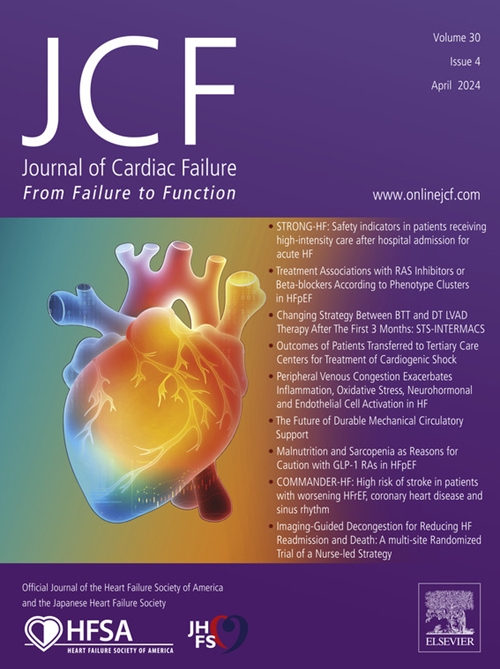Long-term Changes in Body Composition and Exercise Capacity Following Calorie Restriction and Exercise Training in Older Patients with Obesity and Heart Failure With Preserved Ejection Fraction
IF 6.7
2区 医学
Q1 CARDIAC & CARDIOVASCULAR SYSTEMS
引用次数: 0
Abstract
Background
Obesity combined with heart failure with preserved ejection fraction (HFpEF) is the dominant form of HF among older persons. In a randomized trial, we previously showed that a 5-month calorie restriction (CR) program, with or without aerobic exercise training (AT), resulted in significant weight and fat loss and improved exercise capacity. However, little is known regarding the long-term effects of these outcomes after a short-term (5-month) intervention of CR with or without AT in older patients with obesity and HFpEF.
Methods
Sixteen participants from either the CR or CR+AT who experienced significant weight loss ≥ 2 kg were reexamined after a long-term follow-up endpoint (28.0 ± 10.8 months) without intervention. The follow-up assessment included body weight and composition via dual-energy X-ray absorptiometry and exhaustive cardiopulmonary treadmill exercise testing.
Results
Compared to the 5-month time-point intervention endpoint, at the long-term follow-up endpoint, mean body weight increased +5.2 ± 4.0 kg (90.7 ± 11.2 kg vs 95.9 ± 11.9; P < 0.001) due to increased fat mass (38.9 ± 9.3 vs 43.8 ± 9.8; P < 0.001) with no change in lean mass (49.6 ± 7.1 vs 49.9±7.6; P = 0.67), resulting in worse body composition (decreased lean-to-fat mass). Change in total mass was strongly and significantly correlated with change in fat mass (r = 0.75; P < 0.001), whereas there appeared to be a weaker correlation with change in lean mass (r = 0.50; P = 0.051). Additionally, from the end of the 5-month time-point intervention endpoint to the long-term follow-up endpoint, there were large, significant decreases in VO2peak (-2.2 ± 2.1 mL/kg/min; P = 0.003) and exercise time (-2.4 ± 2.6 min; P = 0.006). There appeared to be an inverse correlation between the change in VO2peak and the change in fat mass (r = -0.52; P = 0.062).
Conclusion
Although CR and CR+AT in older patients with obesity and HFpEF can improve body composition and exercise capacity significantly, these positive changes diminish considerably during long-term follow-up endpoints, and regained weight is predominantly adipose, resulting in worsened overall body composition compared to baseline. This suggests a need for long-term adherence strategies to prevent weight regain and maintain improvements in body composition and exercise capacity following CR in older patients with obesity and HFpEF.
老年肥胖和射血分数保留型心力衰竭患者在限制热量和运动训练后身体成分和运动能力的长期变化。
背景:肥胖合并射血分数保留型心力衰竭(HFpEF)是老年人心力衰竭的主要形式。在一项随机试验中,我们曾发现,无论是否进行有氧运动训练(AT),为期 5 个月的卡路里限制(CR)计划都能显著减轻体重和脂肪,并提高运动能力。然而,对于老年肥胖和高房颤患者在短期(5 个月)卡路里限制(CR)干预后这些结果的长期影响,我们知之甚少:16 名参加 CR 或 CR+AT 的患者在体重显著下降≥2 公斤后,在未接受干预的情况下,在长期随访终点(28.0±10.8 个月)后接受了复查。随访评估包括通过双能 X 射线吸收测定法进行的体重和身体成分评估,以及心肺跑步机运动测试:与 5 个月的时间点干预终点相比,在长期随访终点,平均体重增加了 +5.2±4.0kg(90.7±11.2kg 对 95.9±11.9kg),P2 峰值(-2.2± 2.1ml/kg/min,p=0.003)和运动时间(-2.4±2.6min,p=0.006)。VO2峰值的变化与脂肪量的变化之间似乎存在反相关关系(r=-0.52,p=0.062):结论:尽管CR和CR+AT可显著改善肥胖和HFpEF老年患者的身体成分和运动能力,但在长期随访终点期间,这些积极的变化会大大减弱,而且恢复的体重主要是脂肪,导致整体身体成分与基线相比有所恶化。这表明有必要制定长期坚持策略,以防止体重反弹,并维持肥胖和高频心衰老年患者在接受 CR 治疗后身体成分和运动能力的改善。
本文章由计算机程序翻译,如有差异,请以英文原文为准。
求助全文
约1分钟内获得全文
求助全文
来源期刊

Journal of Cardiac Failure
医学-心血管系统
CiteScore
7.80
自引率
8.30%
发文量
653
审稿时长
21 days
期刊介绍:
Journal of Cardiac Failure publishes original, peer-reviewed communications of scientific excellence and review articles on clinical research, basic human studies, animal studies, and bench research with potential clinical applications to heart failure - pathogenesis, etiology, epidemiology, pathophysiological mechanisms, assessment, prevention, and treatment.
 求助内容:
求助内容: 应助结果提醒方式:
应助结果提醒方式:


